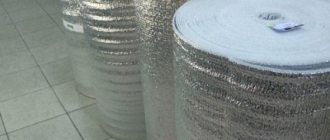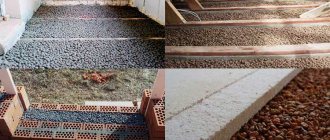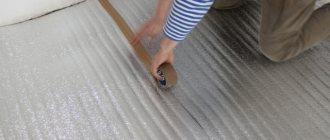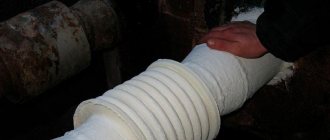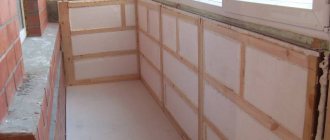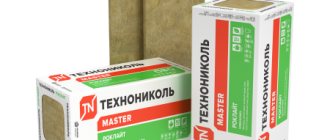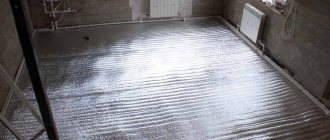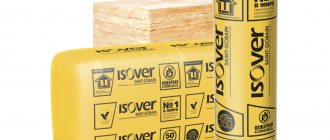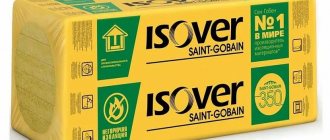The construction of any facility is impossible without the use of thermal insulation materials. With their help, resource costs for heating are reduced. One of the popular solutions is foil penofol. It is chosen for its excellent characteristics. The installation procedure for the material does not contain any difficult aspects. Even a beginner can easily handle this work. Compared to other solutions, it costs significantly less. The result is high-quality and inexpensive insulation of premises.
Penofol is one of the most popular and widespread types of insulation.
Composition and principle of operation of the material
Penofol insulation is obtained by foaming polyethylene with propane-butane or approved phenols in an extruder at high pressure.
The gas expands, a bubble is formed, which cools sharply and hardens at the exit from the nozzle.
The result is a material with a porous closed cell. By adjusting the pressure and temperature of the mixture in the extruder, a material of different porosity, thickness and density is obtained.
A layer of polished aluminum foil is applied on top of the polyethylene, whose heat reflection coefficient reaches 95-97%. If, in addition to thermal insulation, the material is used for waterproofing, two layers of foil are applied to the surface of the polyethylene film using the heat welding method.
How to lay penofol with your own hands
The best insulation effect is achieved if you adhere to the following rules:
- Between the structural element and the insulation itself, you need to leave some distance for the sake of ventilation, no more than a couple of centimeters.
- If you install one-sided penofol, the layer with foil should be directed in the direction where the heat will come from.
- It is better to connect sheets of material joint to joint, which gives uniformity in heat reflection. But if, for example, a loggia is insulated, joining using the overlapping method to a width of up to 10 cm is also acceptable.
- When sealing joints between sheets of materials, tape, also foil, should be used.
It is very important to remember that this material must be attached taking into account the fact that the reflective aluminum foil conducts current. Therefore, if there is wiring nearby, it is necessary to insulate the wires well.
An example of using penofol for insulating walls and floors
Once a material suitable for the operational requirements has been selected, additional waterproofing, protection from steam or heat can no longer be used. It will also be possible to save on the installation process and materials necessary for high-quality insulation and insulation of surfaces. You can also watch several videos on this topic.
Material advantages
A versatile, lightweight, durable material is widely used as insulation and waterproofing material indoors and outdoors.
- Penofol is used for insulating facades, floors, walls, and roofs. It has low vapor permeability, so when using it, an additional layer of vapor barrier is not required.
- High sound insulation and vibration protective properties.
- Light and thin material is easy to install and does not require special tools or skills to carry out the work. It is produced in rolls, sold in meters, which simplifies its transportation to the installation site. Easily cut into pieces of the required length with ordinary scissors.
- Does not emit harmful and toxic substances.
- The material retains heat in winter and serves as a barrier to solar and ultraviolet radiation in summer.
- Protects against electromagnetic radiation.
- Durable and undamaged by insects, mold and mildew.
- Penofol 4 mm thick replaces 8 cm of mineral wool, 2 cm of wood and 3 cm of styrofoam in terms of its functions.
The disadvantages of the material include its high cost compared to other materials; it is not used as insulation under a layer of plaster or wallpaper.
How to choose penofol
It is recommended to consider the following criteria for choosing penofol:
- The price by the thickness, as well as how many layers of aluminum were applied to the reflective surface. The standard size is from three to eight and even ten mm. Penofol with one side - a reflector with a size of 3 or 4 mm, type A - can cost approximately up to 55 rubles / m². 10 mm type B is considered much more expensive and more durable of all; the cost for it can reach from 100 to 130 rubles/m² .
- In stores you can come across the label “Penofol 2000”. We are talking about an analogue of standard material, but cheaper (it costs from 35 rubles/m² ). In terms of strength, according to experts, it is much inferior to classical insulation.
- The best ratio between the cost of the substance and the performance data is shown by penofol 5 mm thick at a cost of approximately 70 rubles / m².
- When you need to insulate the roof or basement rooms, in the basement, on the balcony, for saunas, or walls and ceilings, you can use A-type penofol. When used on wooden floors, it is better to take B-class. C-class is used for metal structures and vehicle insulation.
Technical parameters of penofol
The thickness of the polyethylene foam base is from 2 to 10 mm, the thicker version is up to 30 mm, for areas with cold climates they produce 50 mm. The thickness of aluminum foil is 12-30 microns.
Use temperature range from -400 C to +1000 C, heat reflection coefficient 97%, thermal conductivity from 0.37 to 0.51 W/(m K), water absorption capacity depends on the class of material and varies from 0.35 to 0.7 %.
Foiled penofol has a sound-absorbing capacity of up to 32 dB and is used for soundproofing cabins of lifting equipment, cars, operator rooms in boiler rooms, and smelting shops.
They are used for insulation of refrigeration equipment, freezers, in air conditioners, ventilation systems, for insulation of car interiors, refrigerators, and wagons.
Types of insulation
The type of product depends on the manufacturing features, thickness, number of layers of foil coating and surface topography.
- A - one-sided aluminum coating, used as an additional, starting layer of heat, sound and vapor barrier, attached directly in front of the layer of foam plastic or foam polystyrene.
- B – polyethylene is covered with foil on both sides, the material is used as an independent type of insulation. An ideal option for floor insulation, which will protect against the penetration of cold and retain heat.
- C is a self-adhesive type of insulation covered with foil on one side and a layer of polyurethane or polystyrene glue on the other. A protective film of polyethylene is applied on top of the adhesive composition, which is removed before installation on the surface. When using, you do not need to purchase special mounting adhesive. Self-adhesive penofol is cut into strips of the required length, the protective film is removed gradually as it is applied to the surface. Convenient for processing hard-to-reach areas, corners, and ceilings.
- R – modification of type A material with perforation on the foil layer. Convenient when using arranging an insulating pie if an air gap is required. It is also used as a finishing material in premises, underground structures, production workshops and warehouses.
- ALP is a type of penofol type A in which the polyethylene bubble base is additionally covered with a polyethylene film that creates a water and vapor barrier. Widely used in agriculture, livestock farms, incubators.
- NET – designed to retain heat on heating mains, during the installation of chimneys, and laying pipelines.
- AIR - used in frame construction, a characteristic feature is through holes (perforation), which increases vapor permeability and prevents moisture condensation on the surface of the insulation.
Application
Due to its versatility, the material is suitable for thermal insulation of apartments in multi-storey buildings, country cottages and small summer houses. These can also be office centers, industrial premises, hospitals, baths, warehouses and shopping kiosks. In addition, penofol is used to insulate carriages , shield heating radiators and wrap ventilation or water pipes.
The material is used separately or combined with other materials. Thanks to this insulation, it will be possible to insulate the walls, ceiling and floor. Many professionals use foil foam to process air ducts and hoods.
Features and stages of working with the material
Before starting work, the insulated surface is cleaned of dirt and dust, and the floor is leveled with a cement screed. Select the appropriate type of material; for type A, buy polymer glue.
- Type B is mounted on a prepared sheathing with a beam thickness of 1-2 cm.
- The aluminum layer should be located towards the heat source.
Important! Aluminum is highly electrically conductive; before starting work, it is necessary to insulate the cable connections.
The insulation is laid with an overlap of at least 5 cm, the edges of the connection are carefully fixed with mounting tape.
Penofol insulation requires careful installation. Bends, tears, poorly fastened joints, holes worsen the thermal insulation properties and lead to significant heat losses, especially in strong winds.
Using foil insulation you will retain heat and provide protection from cold, solar energy and electromagnetic radiation.
Cross-linked polyethylene manufacturing technology
This material can be obtained by two methods - radiation and chemical. Let's talk about them in more detail. The chemically cross-linked foam material is produced under high pressure. During the manufacturing process, special antioxidants and reaction stimulants are added to the composition. Next, the base for polyethylene in a thermoplastic state is straightened and formed in accordance with the requirements for the finished product.
In turn, reactors in the form of peroxides act to create cross-links and disintegrate under the influence of high temperatures. In addition, cross-linked foamed polyethylene foil undergoes a reaction of substitution of hydrogen atoms with unsaturated carbon elements. This process makes it possible to form a spatial structure of bound radical elements, which in practical use results in high tensile strength of the material. In the application of radiation technology, the connection of molecules occurs not under the influence of a chemical reaction, but under conditions of a directed beam of energy.
Read with this
- Foil insulation: types, properties and possibilities of use
- Insulation of a veranda in a wooden house
- Insulation for protecting pipes, made of foamed polyethylene (thermal insulation)
- Isover thermal insulation overview
- Underlay for insulation on the ceiling
- Insulating a balcony with panoramic glazing: useful to know
- Mineral wool, its characteristics and insulation composition
- Properties and types of dowel mushrooms for fastening insulation
- Insulation of a concrete floor in an apartment
- Polyethylene: properties and applications


